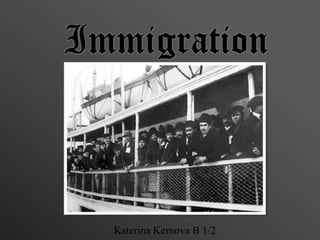
Immigration 1865-1914
- 1. Katerina Kernova B 1/2
- 2. 1870 – Fifteenth Amendment ratified; 1872 – Ballot Act makes voting secret Farmers’ Alliance founded in Britain 1881 – President Garfield assassinated 1876 – Porifiro Diaz becomes dictator 1883 – Brooklyn Bridge completed; of Mexico Civil Service Act adopted 1881 – Anti-Jewish pogroms erupt in 1888 – First electric trolley line opens Russia in Richmond, Virginia 1884 – First subway in London opens 1890 – Sherman Antitrust Act passed 1888 – Brazil ends slavery 1895 – Booker T. Washington gives 1889 – Eiffel Tower completed for Atlanta Compromise speech Paris World Exhibit 1896 – Plessy v. Ferguson establishes 1896 – Athens hosts first modern “separate but equal” doctrine Olympic games U.S. Presidents: R. B. Hayes (1877-1881), J.A. Garfield (1881), C. A. Arthur (1881-1885), G. Cleveland (1885-1889), B. Harrison (1889-1893), G. Cleveland (1893-1897)
- 3. In the late nineteenth century, a major wave of immigration began. Most immigrants settled in cities, where distinctive ethnic neighborhood emerged. Some Americans, however, feared that the new immigrants would not adapt to American culture or might be harmful to American society.
- 4. 1. Immigrants from Europe came to the US from many reasons and entered the country through Ellis Island. 2. Asian immigrants arrived on the West Coast, where they settled mainly in cities 3. Economic concerns and religious and ethnic prejudice led some Americans to push for laws restricting immigration. immigration = 1.The action of coming to live permanently in a foreign country. 2. A government department dealing with applications from foreign citizens who wish to live in a particular country.
- 5. Between the Civil War (1865) and the World War I (1914), 25 million Europeans immigrated to the US. More than half of all immigrants in the US were from eastern and southern Europe. This period is known as “new” immigration. The “old” immigration was before year 1890 and the immigrants were mostly from northern and western Europe. Immigrants were mostly men. Almost everyone came in hope to find a job, or better job, or because of high food prices, or to escape religious persecution.
- 6. Often very difficult Steerage = the cheapest accommodations on a steamship Usually after 14-day journey, the passengers disembarked at Ellis Island, a tiny island in New York Harbor. There was building serving as the processing center for many of the immigrants from Europe. Most immigrants came through Almost all immigrants settled in cities Ellis Island By the 1890s, immigrants made up a Usually they spent there just one large percentage of the population of day major cities Between 1892 and 1954, about 12 Jacob Riis, a Danish-born million immigrants passed through journalist, observed that a map of New Ellis Island York City, “colored to designate Doctors controlled everyone there nationalities, would show more stripes and that, who didn’t pass by the than on the skin of a zebra” inspection, was sent back to Europe Some of the ethnic groups: Italian, Jewish, Catholic, Greece, etc. They learned English pretty fast
- 7. In the mid-1800s, China’s population reached about 430 million, and there wasn’t enough jobs for everyone. Chinese immigrants settled mainly in west cities, where they often worked as laborers or servant or skilled trades. Because native-born Americans kept them out of many businesses, some Chinese people opened their own businesses there. The biggest number of immigrants from Japanese grew between 1900 and 1910. In January 1910 California opened a house on Angel Island for Asian immigrants. The immigrants from Asia were mostly young people.
- 8. The wave of immigrants led to increased feelings of nativism. In the late 1800s, anti- immigrant feelings focused mainly on Asians, Jews, and eastern Europeans. The reasons were religious and the fear of having not enough jobs for native-born Americans. Nativism = 1. The policy of protecting the interests of native-born or established inhabitants against those of immigrants. 2. A return to or emphasis on traditional or local customs, in opposition to outside influences.
- 9. Founding of anti-immigrants organizations In 1887, Henry Bowers found the American Protective Association. Its members vowed not to hire or vote for Catholics. The Irish immigrants suffered most from the anti-Catholic feeling. Irish couldn’t find well-paid jobs Enacted in 1882, the law banned convicts, paupers, and the mentally disabled from immigrating to the US. The law also placed a 50¢ per head tax on each newcomer.
- 10. Anti-Chinese sentiment sometimes led to racial violence In 1882 Congress passed the Chinese Exclusion Act. The law barred Chinese immigration for 10 In 1905 Theodore Roosevelt years and prevented the Chinese commissioned a study on how already in the country from immigrants were admitted to the becoming citizens. Congress nation. renewed the law in 1892 and made The “new” immigrants were permanent in 1902. It wasn’t thought to be less intelligent than repealed until 1943. the “old” immigrants. Law to reduce immigration from southeastern European nations.
- 11. Italians: cholera epidemic in 1880s; Italians: unskilled labor – dock land shortage for work, construction, railroads; some peasants, landlords charge high skilled labor , such as bricklayers, rent; food shortage; poverty; stonemasons, and other trades unemployment East Europeans: Poles > farmers, East Europeans: Russian, Poles > coal miners, steel and textile land shortage for millworkers, meatpacking; Jews > peasants, unemployment, high laborers, garment workers, taxes, long military draft; Jews > merchants discrimination, poverty, recurring Chinese: railroad and construction pogroms workers, some skilled labor; Chinese: famine; land shortage for merchants, small businesses peasants; civil war (Taiping rebellion)
- 12. Video
- 13. The American Vision, 2010, The McGraw- Hill Companies http://www.wikipedia.org/
